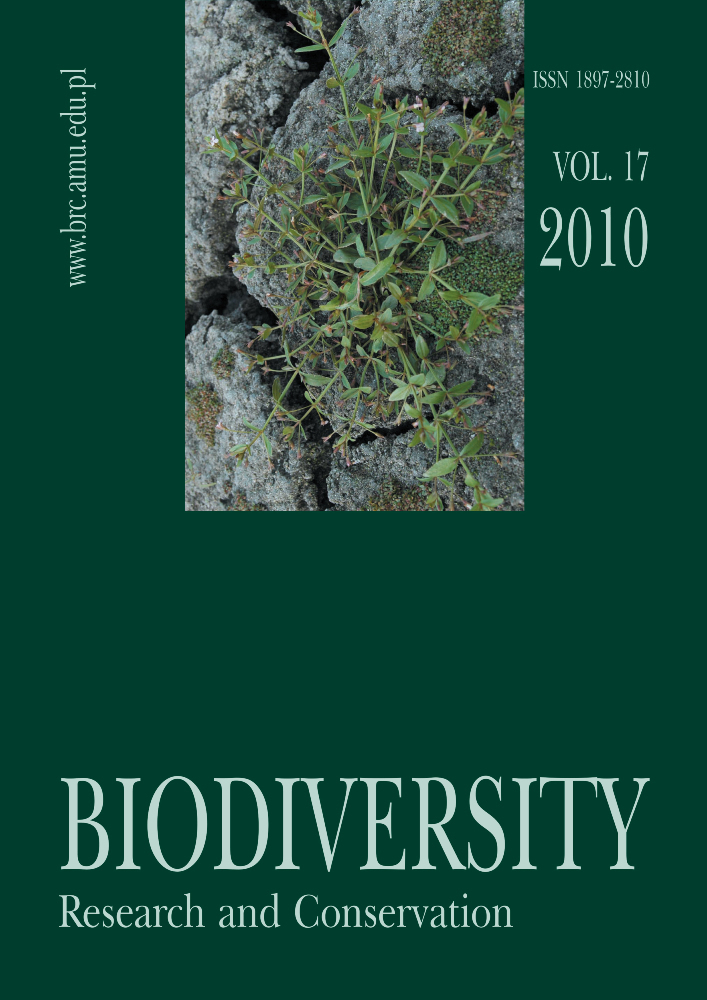Abstract
The impact of the 17th-19th century iron ore mining on the current state of vegetation cover of the Gielniowski Hump, an upland region situated within the Old Polish Industrial Region (a former centre of mining and smelting), was studied. In the course of the research, the detailed floristic lists were compiled using the cartogram method (ATPOL grid) and phytosociological relevés were made according to the Braun-Blanquet method. Relevés were taken both at the post-mining sites (on spoil banks) and, for comparative purposes, in the adjacent, not affected areas. The obtained results show significant differences between the flora and vegetation of the sites affected and unaffected by mining. These differences result from the changed mineralogical composition of soil in the post-mining areas, which has lead to an increase in the proportion of mesophilous forest communities and in the number of species of the class Querco-Fagetea as compared to the unaffected sites. Overall, the former iron ore mining activity has increased the biodiversity level in the Gielniowski Hump mesoregion due to an increase in the total number of species in the area, brought about by the formation of a mining-related habitat mosaic.
References
Adamczyk B. 1965a. Studia nad kształtowaniem się związków pomiędzy podłożem skalnym i glebą. Część I. Gleby rezerwatu leśnego "Świnia Góra" wytworzone z utworów formacji piaskowca pstrego (dolnego triasu). Acta Agr. Silv., Seria Leśna 5: 3-60.
Adamczyk B. 1965b. Wtórne przekształcenia okrywy glebowo-roślinnej w objętych starym kopalnictwem północno-zachodnich rejonach Gór Świętokrzyskich. Roczn. Gleb. Dod. 15: 437-442.
Balcerkiewicz S. & Pawlak G. 1990. Zarastanie zwałowiska zewnętrznego kopalni odkrywkowej węgla brunatnego w aspekcie analizy florystyczno-ekologicznej występujących tam zbiorowisk roślinnych. Arch. Ochr. Środ. 2: 7-20.
Dzwonko Z. 2007. Przewodnik do badań. In: Vademecum Geobotanicum, pp. 304. Sorus, Instytut Botaniki Uniwersytetu Jagiellońskiego, Poznań-Kraków.
Fabijanowski J. & Zarzycki K. 1965. Roślinność rezerwatu leśnego Świnia Góra" w Górach Świętokrzyskich. Acta Agr. Silv., Seria Leśna 5: 61-103.
Faliński J. B. 1990. Kartografia geobotaniczna. Cześć 1. Zagadnienia ogólne. Kartografia florystyczna i fitogeograficzna. 284 pp. Państwowe Przedsiębiorstwo Wydawnictw Kartograf. im. E. Romera, Warszawa-Wrocław.
Griffith J. J. & Toy T. J. 2001. Evolution in revegetation of iron-ore mines in Minas Gerais State, Brazil. Unasylva 207(52): 9-15.
Guldon Z. 2001. Old Polish Industrial District. In: P. Pierściński (ed.). Old Polish Industrial District, pp. 32-35. Sam-Wil, Kielce.
Hougen K. E. 2009. Long-term effects of industrial history on the forest flora of southeastern Ohio. pp.125. College of Arts and Sciences of Ohio University, Ohio.
Kershaw K. A. 1978. Ilościowa i dynamiczna ekologia roślin. 383 pp. PWN, Warszawa.
Kleczkowski 1970. Rudy żelaza w utworach pstrego piaskowca północnego obrzeżenia Gór Świętokrzyskich. Prace Muzeum Ziemi 15(1): 193-221.
Kołodziejek J. 1999. Rzadkie i interesujące gatunki roślin naczyniowych na górniczo zniekształconych obszarach środkowej części Częstochowskiego Okręgu Rudonośnego. Fragm. Flor. Geobot. 6(39-43): 39-43.
Kołodziejek J. 2001. Roślinność łąkowo-bagienna na górniczo zniekształconych obszarach Częstochowskiego Okręgu Rudonośnego. 169 pp. Wyd. Uniw. Łódzkiego, Łódź.
Kondracki J. 2000. Geografia fizyczna Polski. 441 pp. PWN, Warszawa.
Kurowski J. K. 1993. Dynamika fitocenoz leśnych w rejonie kopalni odkrywkowej Bełchatów. 171 pp. Wyd. Uniw. Łódzkiego, Łódź.
Li S., Yang B. & Wu D. 2008. Community succession analysis of naturally colonized plants on coal gob piles in Shanxi Mining Areas, China. Water Air Soil Pollut. 193: 211-228.
Matuszkiewicz W. 2001. Przewodnik do oznaczania zbiorowisk roślinnych Polski. In: J. B. Faliński (ed.). Vademecum Geobotanicum 3, pp. 537. Wyd. Nauk. PWN, Warszawa.
Mirek Z., Piękoś-Mirkowa H., Zając A. & Zając M. 2002. Flowering plants and pteridophytes of Poland. A checklist. In: Z. Mirek (ed.). Biodiversity of Poland 1, pp. 442. W. Szafer Institute of Botany, Polish Academy of Sciences, Kraków.
MWH Energy & Infrastructure 2003. Best management practices manual: case studies of model zinc, bauxite, iron ore and limestone mining operations. Vol. 2, i-ii53 pp. Ministry of Environment and Forest Government of India, India.
Ochyra R., Żarnowiec J. & Bednarek-Ochyra H. 2003. Census Catalogue of Polish Mosses. In: Z. Mirek (ed.). Biodiversity of Poland 3, 372 pp. Polish Academy of Sciences, Institute of Botany, Kraków.
Ottoa R., Krüsi B. O., Burgac C. A. & Fernández-Palaciosa J. M. 2006. Old-field succession along a precipitation gradient in the semi-arid coastal region of Tenerife. Journal of Arid Environments 65: 156-178.
Pawłowski B. 1977. Skład i budowa zbiorowisk roślinnych oraz metody ich badania. In: W. Szafer & K. Zarzycki (ed.). Szata roślinna Polski, 1, pp. 237-269. PWN, Warszawa.
Podgórska M. 2008. Zagadnienia fitogeograficzne i flora naczyniowa Garbu Gielniowskiego. Ph.D. Thesis, Department of Plant Taxonomy and Phytogeography, Institute of Botany, Jagiellonian University in Kraków.
Podgórska M. 2009. Wpływ dawnego górnictwa rud żelaza na zmiany we florze i roślinności leśnej północnego przedpola Gór Świętokrzyskich. In: M. Staniaszek-Kik & G. J. Wolski (ed.). Dynamika roślinności w warunkach antropopresji i ochrony, 38 pp. Uniwersytet Łódzki, Łódź.
Podgórska M. 2010a. Flora roślin naczyniowych Garbu Gielniowskiego (Wyżyna Małopolska). Zeszyty Naukowe UJ, Prace Botaniczne (in print).
Podgórska M. 2010b. Skarbowa Góra - godny ochrony obiekt przyrodniczy na Garbie Gielniowskim (Wyżyna Małopolska). Roczn. Świętokrz. (in print).
Riley C. V. 1960. The ecology of water areas associated with coal strip-mined lands in Ohio. The Ohio Journal of Science 60(2): 106-121.
Swałdek M. 1983. Przekształcenia pokrywy glebowej i zbiorowisk roślinnych w Staropolskim Okręgu Przemysłowym. Dok. Geog. 4: 1-86.
Sweet P. C. 2006. Bettie Martin iron mine and old's furnance North Garden, Virginia. Virginia Minerals 49(1-2): 1-8.
Usepa O. 2006. Iron Mountain Mine case study. Abandoned Mine Lands. pp. 17 Environmental Protection Agency, USA.
Zając A. 1978. Atlas of distribution of vascular plants in Poland (ATPOL). Taxon 27(5/6): 481-484.
Zając A. & Zając M. (eds.). 2001. Distribution Atlas of Vascular Plants in Poland. xii? pp. Edited by Laboratory of Computer Chorology, Institute of Botany, Jagiellonian University, Cracow.
Zarzycki K., Trzcińska-Tacik H., Różański W., Szeląg Z., Wołek J. & Korzeniak U. 2002. Ecological indicator values of vascular plants of Poland. In: Z. Mirek (ed.). Biodiversity of Poland 2, 183 pp. W. Szafer Institute of Botany, Polish Academy of Sciences, Kraków.




